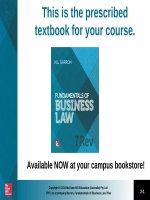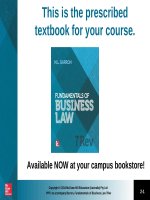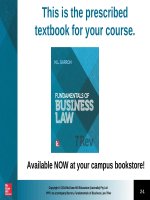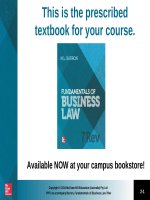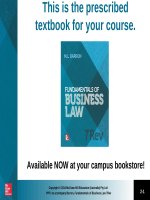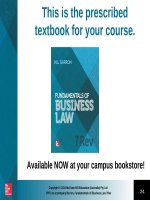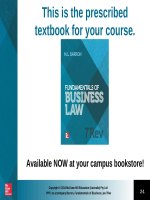- Trang chủ >>
- Thạc sĩ - Cao học >>
- Luật
Lecture Fundamentals of business law (7/e): Chapter 2 - M.L Barron
Bạn đang xem bản rút gọn của tài liệu. Xem và tải ngay bản đầy đủ của tài liệu tại đây (498.92 KB, 29 trang )
This is the prescribed
textbook for your course.
Available NOW at your campus bookstore!
Copyright © 2014 McGraw-Hill Education (Australia) Pty Ltd
PPTs to accompany Barron, Fundamentals of Business Law 7Rev
•2-1
THE AUSTRALIAN COURT
SYSTEM
CHAPTER 2
Copyright © 2014 McGraw-Hill Education (Australia) Pty Ltd
PPTs to accompany Barron, Fundamentals of Business Law 7Rev
•2-2
Learning objectives
At the end of this chapter you should understand:
•
•
•
•
•
•
•
•
•
the doctrine of the separation of powers
the role played by the courts in making law
the jurisdiction of federal and state courts and tribunals
the doctrine of precedent, including the difference
between a binding and a persuasive precedent
the adversary system of justice
the trial process
the way to read a statue effectively and the purpose of
dividing statutes into several parts
the rules of statutory interpretation and their application to
a set of facts
how to effectively read a case reported in a law report.
Copyright © 2014 McGraw-Hill Education (Australia) Pty Ltd
PPTs to accompany Barron, Fundamentals of Business Law 7Rev
•2-3
Introduction
• Businesses operate within the Australian
legal framework.
• You need to understand the role played by
the various courts in Australia, how they
operate and make decisions and how such
decisions can effect the regulation and
operation of business.
• You need to understand the effect of
legislation upon the regulation and
operation of business.
Copyright © 2014 McGraw-Hill Education (Australia) Pty Ltd
PPTs to accompany Barron, Fundamentals of Business Law 7Rev
•2-4
The doctrine of separation of
powers
•
This is the foundation upon which Australia’s system of
democracy rests.
• It puts checks and balances in place to stop one arm of
government having absolute power.
• Essentially provides that government is composed of three
arms who should be responsible for separate functions:
– the legislature (parliament), which makes the law
– the judiciary (courts), which interprets and enforces the law
– the executive (ministers/cabinet), which administers the law.
• It provides that one arm of government should not be controlled
by either of the other two arms, nor should it exercise the
functions of another.
Copyright © 2014 McGraw-Hill Education (Australia) Pty Ltd
PPTs to accompany Barron, Fundamentals of Business Law 7Rev
•2-5
Laws made by the courts
• Called common law, case law, judge-made
law
• Courts interpret statutes and apply commonlaw principles.
• In doing this, courts may establish legal
principles that can be used in subsequent
cases with similar facts.
Copyright © 2014 McGraw-Hill Education (Australia) Pty Ltd
PPTs to accompany Barron, Fundamentals of Business Law 7Rev
•2-6
The doctrine of precedent
(stare decisis)
•
Courts should treat similar cases in similar fashion to
encourage consistency and certainty in decision making
and fairness for litigants.
•
Precedent: a past judgement of a court cited as
authority for the legal principle embodied in a new
decision.
•
A judgement is composed of two parts:
– Ratio decidendi: the reason for the decision made
by the judges.
– Obiter dictum: observations made by judges in
explaining or further clarifying their decisions.
Copyright © 2014 McGraw-Hill Education (Australia) Pty Ltd
PPTs to accompany Barron, Fundamentals of Business Law 7Rev
•2-7
Precedents
• Binding precedent
Courts must follow the ratio decidendi
of judgements made in higher courts in
the same court hierarchy.
• Persuasive precedent
Courts may follow the ratio decidendi of
all other courts not higher than them in
the same court hierarchy, or the obiter
dicta of all courts.
Copyright © 2014 McGraw-Hill Education (Australia) Pty Ltd
PPTs to accompany Barron, Fundamentals of Business Law 7Rev
•2-8
Advantages and disadvantages
of precedent
Copyright © 2014 McGraw-Hill Education (Australia) Pty Ltd
PPTs to accompany Barron, Fundamentals of Business Law 7Rev
•2-9
The hierarchy of the Australian
courts
• A dual system:
– Federal legal system
– State legal system
• Courts are graded in order of
importance—‘hierarchy of courts’.
• Jurisdiction of courts
– Original jurisdiction:
Certain matters can be heard for the first time
– Appellate jurisdiction:
Hearing a matter on appeal from another court
Copyright © 2014 McGraw-Hill Education (Australia) Pty Ltd
PPTs to accompany Barron, Fundamentals of Business Law 7Rev
•2-10
Importance of a court hierarchy
• Serious matters are heard by higher
courts, with more experienced judges
• Ensures doctrine of precedent can
operate through appellate jurisdiction
• Allows appeals against decisions on the
basis of mistakes of law
• Allows for specialisation
Copyright © 2014 McGraw-Hill Education (Australia) Pty Ltd
PPTs to accompany Barron, Fundamentals of Business Law 7Rev
•2-11
Court hierarchy
HIGH COURT
OF AUSTRALIA
FEDERAL COURT OF AUST.
INDUSTRIAL
DIVISION
GENERAL DIVISION
FAMILY COURT OF AUST.
SUPREME COURTS
FEDERAL
MAGISTRATES
COURT
DISTRICT COURTS
MAGISTRATES &
LOCAL COURTS
Copyright © 2014 McGraw-Hill Education (Australia) Pty Ltd
PPTs to accompany Barron, Fundamentals of Business Law 7Rev
•2-12
Cross-vesting laws
• A disadvantage of a federal system is
the potential for legal disputes to
involve both state and federal court
hierarchies.
• To avoid this problem we have
cross-vesting laws:
– State courts can exercise jurisdiction over
federal matters.
– Federal courts can exercise jurisdiction over
state matters.
Copyright © 2014 McGraw-Hill Education (Australia) Pty Ltd
PPTs to accompany Barron, Fundamentals of Business Law 7Rev
•2-13
Specialist federal tribunals
• Administrative Appeals Tribunal—reviews
decisions of Commonwealth departments and
statutory bodies.
• Australian Competition and Consumer
Commission (ACCC)—enforces the restrictive
trade practices provisions and the consumer
protection provisions of the Competition and
Consumer Act 2010 (Cwlth).
• Australian Competition Tribunal—hears
authorisation applications.
• Native Title Tribunal—deals with native title
applications.
Copyright © 2014 McGraw-Hill Education (Australia) Pty Ltd
PPTs to accompany Barron, Fundamentals of Business Law 7Rev
•2-14
Specialist federal tribunals (cont.)
• Human Rights and Equal Opportunity
Commission (HREOC)—addresses the
human rights concerns of both individuals
and groups.
• The Migration Review Tribunal and the
Refugee Review Tribunal—makes
independent and final decisions in relation to
visas to travel to, enter or stay in Australia.
Copyright © 2014 McGraw-Hill Education (Australia) Pty Ltd
PPTs to accompany Barron, Fundamentals of Business Law 7Rev
•2-15
Specialist state tribunals
• Small claims tribunals—for consumers to
complain about activities of traders.
• Residential tenancies tribunals—for landlords
and tenants to resolve disputes relating to matters
such as payment or raising of rent, security bonds,
maintenance of premises and eviction.
• Industrial relations commissions—prevent
and settle disputes, determine industrial matters,
and may approve statutory employment
agreements.
Copyright © 2014 McGraw-Hill Education (Australia) Pty Ltd
PPTs to accompany Barron, Fundamentals of Business Law 7Rev
•2-16
Adversary system of justice
• Features
– Two opposing or adverse sides in a dispute
– An independent person hears the dispute and
ensures compliance with certain rules.
– Overall concept that the competitive arena will
produce the best arguments and the truth will be
ascertained by the decision maker, be it judge or jury.
• Matters of proof:
– Standard of proof: the degree of proof required in
order to succeed in a legal action.
– Burden of proof: which party is required to prove its
case (in a legal proceeding).
Copyright © 2014 McGraw-Hill Education (Australia) Pty Ltd
PPTs to accompany Barron, Fundamentals of Business Law 7Rev
•2-17
The trial process
• Opening by prosecution/plaintiff
• Calling of witnesses by the prosecution/plaintiff:
– Examination-in-chief
– Cross-examination
– Re-examination
• Opening by defence/defendant
• Calling of witnesses by the defence/defendant
(Same process as for prosecution/plaintiff)
Copyright © 2014 McGraw-Hill Education (Australia) Pty Ltd
PPTs to accompany Barron, Fundamentals of Business Law 7Rev
•2-18
The trial process (cont.)
• Closing addresses
• Summing up to jury by judge (if a jury is
used)
• Judgment/verdict
• Sentencing (for a defendant that has been
found guilty in a criminal trial)
Copyright © 2014 McGraw-Hill Education (Australia) Pty Ltd
PPTs to accompany Barron, Fundamentals of Business Law 7Rev
•2-19
The standard of proof
Criminal matters
Civil matters
Standard of
proof
Beyond a
reasonable doubt
On the balance of
probabilities
Burden of
proof
Prosecution
Plaintiff
Copyright © 2014 McGraw-Hill Education (Australia) Pty Ltd
PPTs to accompany Barron, Fundamentals of Business Law 7Rev
•2-20
Understanding Acts of Parliament
• Look at how the statute is structured.
• Rules of statutory interpretation
• Parts of an Act:
– Number of an act
– Long title and short title
– Enacting words
– Date
– Table of contents
– Sections, subsections and paragraphs
– Marginal notes
– Parts and divisions
– Definition sections
Copyright © 2014 McGraw-Hill Education (Australia) Pty Ltd
PPTs to accompany Barron, Fundamentals of Business Law 7Rev
•2-21
Acts Interpretation Acts
• These statues assist in the interpretation
of Acts of Parliament.
• Commonwealth Acts Interpretation Act
1901, s15AA(1):
'In the interpretation of a provision of an Act a
construction that would promote the purpose or
object underlying the Act (whether that purpose or
object is expressly stated in the Act or not) shall be
preferred to a construction that would not promote
that purpose or object.'
Copyright © 2014 McGraw-Hill Education (Australia) Pty Ltd
PPTs to accompany Barron, Fundamentals of Business Law 7Rev
•2-22
Rules of statutory interpretation
The literal rule:
The courts are to interpret the words used
in an Act of Parliament literally as far as
they can, i.e. they must give the words
used in statutes the same meaning that
they have in everyday use.
The golden rule:
The courts may depart from a literal reading of
the Act to prevent an absurd result.
Copyright © 2014 McGraw-Hill Education (Australia) Pty Ltd
PPTs to accompany Barron, Fundamentals of Business Law 7Rev
•2-23
Rules of statutory interpretation
(cont.)
The mischief rule:
The courts consider the mischief or problem
that existed before the statute was passed
and interpret the statute in a way that is
consistent with the problem or mischief that
is being addressed.
Copyright © 2014 McGraw-Hill Education (Australia) Pty Ltd
PPTs to accompany Barron, Fundamentals of Business Law 7Rev
•2-24
Rules of statutory interpretation
(cont.)
The purpose approach:
• Where a literal interpretation is not
possible (e.g. the words are ambiguous),
the court may interpret the statute
according to the original purpose or
policy underlying its enactment.
• Information other than statute can be
used in order to understand what was
meant to be achieved.
Copyright © 2014 McGraw-Hill Education (Australia) Pty Ltd
PPTs to accompany Barron, Fundamentals of Business Law 7Rev
•2-25
